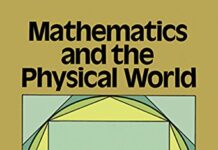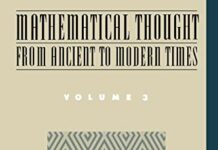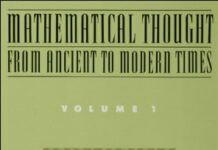
Ebook Info
- Published: 1985
- Number of pages: 672 pages
- Format: PDF
- File Size: 10.79 MB
- Authors: Morris Kline
Description
Practical, scientific, philosophical, and artistic problems have caused men to investigate mathematics. But there is one other motive which is as strong as any of these — the search for beauty. Mathematics is an art, and as such affords the pleasures which all the arts afford.” In this erudite, entertaining college-level text, Morris Kline, Professor Emeritus of Mathematics at New York University, provides the liberal arts student with a detailed treatment of mathematics in a cultural and historical context. The book can also act as a self-study vehicle for advanced high school students and laymen. Professor Kline begins with an overview, tracing the development of mathematics to the ancient Greeks, and following its evolution through the Middle Ages and the Renaissance to the present day. Subsequent chapters focus on specific subject areas, such as “Logic and Mathematics,” “Number: The Fundamental Concept,” “Parametric Equations and Curvilinear Motion,” “The Differential Calculus,” and “The Theory of Probability.” Each of these sections offers a step-by-step explanation of concepts and then tests the student’s understanding with exercises and problems. At the same time, these concepts are linked to pure and applied science, engineering, philosophy, the social sciences or even the arts.In one section, Professor Kline discusses non-Euclidean geometry, ranking it with evolution as one of the “two concepts which have most profoundly revolutionized our intellectual development since the nineteenth century.” His lucid treatment of this difficult subject starts in the 1800s with the pioneering work of Gauss, Lobachevsky, Bolyai and Riemann, and moves forward to the theory of relativity, explaining the mathematical, scientific and philosophical aspects of this pivotal breakthrough. Mathematics for the Nonmathematician exemplifies Morris Kline’s rare ability to simplify complex subjects for the nonspecialist.
User’s Reviews
Editorial Reviews: About the Author Morris Kline: Mathematics for the Masses Morris Kline (1908–1992) had a strong and forceful personality which he brought both to his position as Professor at New York University from 1952 until his retirement in 1975, and to his role as the driving force behind Dover’s mathematics reprint program for even longer, from the 1950s until just a few years before his death. Professor Kline was the main reviewer of books in mathematics during those years, filling many file drawers with incisive, perceptive, and always handwritten comments and recommendations, pro or con. It was inevitable that he would imbue the Dover math program ― which he did so much to launch ― with his personal point of view that what mattered most was the quality of the books that were selected for reprinting and the point of view that stressed the importance of applications and the usefulness of mathematics. He urged that books should concentrate on demonstrating how mathematics could be used to solve problems in the real world, not solely for the creation of intellectual structures of theoretical interest to mathematicians only. Morris Kline was the author or editor of more than a dozen books, including Mathematics in Western Culture (Oxford, 1953), Mathematics: The Loss of Certainty (Oxford, 1980), and Mathematics and the Search for Knowledge (Oxford, 1985). His Calculus, An Intuitive and Physical Approach, first published in 1967 and reprinted by Dover in 1998, remains a widely used text, especially by readers interested in taking on the sometimes daunting task of studying the subject on their own. His 1985 Dover book, Mathematics for the Nonmathematician could reasonably be regarded as the ultimate math for liberal arts text and may have reached more readers over its long life than any other similarly directed text. In the Author’s Own Words:”Mathematics is the key to understanding and mastering our physical, social and biological worlds.” “Logic is the art of going wrong with confidence.” “Statistics: the mathematical theory of ignorance.” “A proof tells us where to concentrate our doubts.” ― Morris Kline
Reviews from Amazon users which were colected at the time this book was published on the website:
⭐A spectrum exists in the books written by or about mathematicians and mathematics, and this spectrum is heavily weighted at the extremes. At one end, we have books purely verbal, descriptive and, more often than not, hagiographic in their descriptions of great mathematicians and their discoveries. – I suppose one could denominate these as mathematics groupie books. At the other end of the spectrum, we have straightforward mathematics textbooks, rather dry and boring, which roll off the presses with the regularity of the academic terms. To split the difference, to write a literate, narrative book on mathematics, is to attempt something akin to the labours of Hercules and, in the end, impossible to do perfectly, rather like trisecting an angle. Kline, however, does a bang-up job here, and approaches the limit – so to speak – of what is possible. Good show, Morris! But, as many other reviewers have made clear, this book should have printed across its cover the words above the entrance to Plato’s Academy: “Let no man ignorant of mathematics enter here.” It is a bit of a catch-22 for someone who wants to learn mathematics but is put off by textbooks; you really have to already possess a fluency in the mathematical tongue, to possess a flair for the subject, in order to appreciate the sweep of this really quite grand book. Some pages of the book are simply equation followed by equation leading to a satisfying simplification or representing a derivation. If you can’t follow these steps – sometimes quite involved – then you simply won’t arrive at the “Aha!” moments which are the chief delight of this book. To quote Kline, “In his wisdom, Thales perceived what we shall perceive as we follow the story of mathematics, that the obvious is far more suspect than the abstruse.” The abstruse insights in which this book abounds can only be reached by a competent grasp of mathematical methodology.That being said, Kline is a whimsical and almost lyrical writer – a bit of a shocker for a book on mathematics! He has a wry wit which he gives full rein to herein. In describing the Greeks and their obsession with astronomy, he observes, “The problem of finding the design of planetary motions continued to engage the minds of the Greeks, possibly because they were not distracted by the `heavenly’ stars of stage, screen, and radio with whom many modern minds seem preoccupied.” His prose is rich in such quips. The book is actually a lark to read at points.But the heart of the book is unvarnished mathematics – with which I have a slight problem. He covers the derivation of trigonometric functions splendidly, as well as their uses, as well as the kinetics, or mathematics of motion. But his account of the calculus is rather sparse for my taste. Any treatment of derivatives and integrals without mention, account or derivation of the fundamental theorem is, to my mind, lacking. Further, his derivation of the quadratic formula is absurdly complex and takes pages. It is true, as one reviewer noted, that most students are only presented with the equation and not given its derivation. But the derivation is – comparatively – simple. I worked it out on my own when I was in school, and it need only cover one page, at maximum.The book is really quite an achievement. But I’m only giving it four stars because it is extremely uneven: No fundamental theorem of the calculus but reams about projectile motion etc. As a bonus, I’ll tack on as a comment, once the review is posted, Kline’s mischievous proof that 2=1 for the prospective reader to see if he can suss out the flaw in it. If the mathematics leaves you stymied this is not the book for you. On the other hand, if you follow the mathematics quite easily, but are left baffled and staring at the page, determined to suss out the mathematical solecism embedded in it, then you poseess just the sort of questing mind that will delight in this tome!
⭐For a long time, I’ve been searching for a book exactly like this one. Somewhat embarrassed by my ignorance of math, I wanted to relearn what I had forgotten in college, and perhaps go further. But I didn’t want to simply learn math; I wanted to learn its history, how it shaped and was shaped by the cultures in which it grew. This is a tall order, requiring both historical and mathematical understanding; but Kline is equal (or, perhaps, almost equal) to the task.Before I get into the positive qualities of this book, I should note its flaws. As another reviewer pointed out, Kline’s beginning chapter on history is inept, even offensive. He heaps praise upon praise when describing the accomplishments of the Greeks, and dismisses the contributions of the Arabs, Babylonians, Egyptians, and Indians with a wave of the hand. He even relays the story of the Arabs destroying the library, which historians have seen fit to doubt as far back as Edward Gibbon. For Kline, mathematics made a brilliant beginning with the Greeks, and then stayed more or less the same until the Enlightenment. The extent to which that is true, I know not; but it at least seems unlikely to me.Thankfully, the book gets markedly better after that. (One shouldn’t judge a book by the cover, or even the first chapter, apparently.) For, whatever Kline lacks as a historian, he makes up as a pedagogue. Kline doesn’t simply move from arithmetic to geometry to algebra to trigonometry, but instead situates every subject within a specific historical period and practical problem. For example, he teaches trigonometry by using the kind of problems that the Alexandrian Greeks, such as Ptolemy and Eratosthenes, were tackling: the distance from the earth to the moon, the radius of the earth, the establishment of longitude and latitude. Every chapter comes with biographical sketches of the major thinkers involves, as well as some practical problem that the mathematical theory would solve.Following this procedure, Kline manages to take the most abstract of all abstract subjects, and to make it exquisitely human. In school, we are taught trigonometry by showing us how to plug numbers into a calculator. Kline shows us that trigonometry allows us to chart the earth, and measure the heavens. We encounter Newton measuring the refraction of light, and Galileo plotting the course of cannonballs. We learn how sinusoidal motion allows us to measure time, and how the Renaissance painters invented projective geometry in their attempt to create realistic perspective.In sum, Kline shows mathematics for what it is: a tremendously exciting intellectual endeavor–one that has expanded our knowledge of the universe immeasurably. Math is not born of the dreams of philosophers (at least, not exclusively), but has been, and continues to be, integral to the solution of everyday problems. It’s curious that something only accessible to the mind allows us to make sense of our senses. In short, Kline has given me the greatest gift a teacher can give–not knowledge, but wonder.
⭐I purchased the book because of the reviews–throughout the years–here and other places. I thought it was worth a try, and after 20 minutes of reading the book, I felt I should share it with my wife–who is an engineer, but is not a lover of mathematics. She appreciates math and appreciates the opportunities math has provided her, but she (and I) do not enjoy the archaic learning methods–taught throughout the U.S.I thought to myself, she’ll likely say that’s nice, but pass on the opportunity to read the book; the truth is she did pass on the chance to read the book. However, the reason she chose to pass on reading my book, which I saw as our book (if she was interested in the book), was such, that she wanted her own book–to mark up, dog-ear, and make her very own.I cannot stress to everyone how surprised I was to find her interested in Mathematics for the Nonmathematician! My wife has read more of the book than I have, and she does so very regularly. My wife has even gone so far that, she asks me to go to bed an hour early, so that we may discuss the book before going to sleep!The bottom line is this, my wife requested her own book after 30 minutes of reading; and she is so fascinated by the history and principles of mathematics, that she regularly requests an hour to discuss what she read. This book is AWESOME! FANTASTIC! and SIMPLISTIC!(Don’t take my word for it, spend the few dollars to read it yourself…)
⭐I throughly enjoyed this book, as someone who is trying to brush up and improve my understanding of mathematics, the best aspect of this book is the historical and chronological direction it takes, starting from the ancients greeks ending with modern day mathematical concepts such as non-euclidean geometry; but, more importantly, expressing why the fields of mathematics developed into what they are today by highlighting the problems they were trying to solve in their respective time periods, with mathematical examples present in most chapters.I do want to stress two predominant points: the first being, that this book does go into some depth of the topics it covers, but approaches topics in a more encompassing manner, in other words, if you are looking for very in depth content about a specific subject, then this book IS NOT for you. The second point being, a fair amount of the book deals with the history of mathematics, which is refreshing and insightful, but it is just a heads up.
⭐I must admit I always had an allergy to Mathematics. Now I understand that was because I was never taught the underlying concepts and history of Mathematics. The author of this book clearly explains why Mathematicians must do things the way they do and the concepts and history behind the methods used in Mathematics. I have barely skimmed the surface of the book, but I already feel it has helped me to look at things with a new perspective. I strongly recommend this book to anyone who needs a strong foundation in Mathematics.
⭐This is the book on mathematics I have been hoping to find for many years.For a non-mathematician who wants to get a good functioning overview and practical understanding of the whole subject this book is perfect. The book takes a historical and philosophical approach taking us from the Egyptians, Babylonians, Greeks, Hindus and Arabs up to the modern era and Einstein. However, despite all of the fascinating background historical information, this is not a history of mathematics, it is a real mathematics book and is full of clear examples of problems and additional exercises (with answers).The book progresses from logic, to arithmetic, algebra, geometry, trigonometry, calculus, statistics, probability, and non-Euclidian geometries.The book is also rich on its discussions of mathematical applications and goes into some depth regarding astronomy, painting and perspective, physical laws of motion and gravity, and music.Morris Kline was Emeritus Professor of Math and New York University. The book was first published in 1967 and is a real classic.
⭐The book is a journey through the all major human conceptual and analytical thinking that have more than anything else shaped our modern day world and at the same time it can serve as a manual for self-study. This rather unusual approach to his subject is doubtlessly a work of art in itself and can only increase our appreciation for Mathematics, that some modern-day physicists are proclaiming to be only substantial reality behind the Universe and phenomenon of existence…
⭐Mathematics as seen from the outside. The author guides you through the history of mathematics and how one discover led to the other. He does it in an entertaining yet serious way.
Keywords
Free Download Mathematics for the Nonmathematician in PDF format
Mathematics for the Nonmathematician PDF Free Download
Download Mathematics for the Nonmathematician 1985 PDF Free
Mathematics for the Nonmathematician 1985 PDF Free Download
Download Mathematics for the Nonmathematician PDF
Free Download Ebook Mathematics for the Nonmathematician



